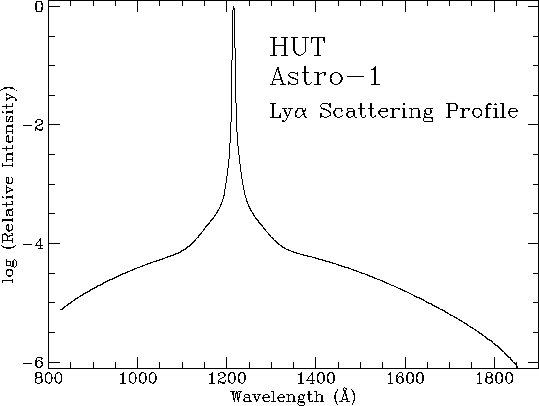 |
Scattered light from geocoronal Ly![]() accounts for the remainder of the
background in a spectrum, and for the largest apertures it can dominate
over the dark count during orbital daylight.
The holographic grating used in the HUT spectrograph has excellent scattered
light characteristics with no ghosts. Far from the line center, scattered light
is roughly uniform across the spectrum at a level of
accounts for the remainder of the
background in a spectrum, and for the largest apertures it can dominate
over the dark count during orbital daylight.
The holographic grating used in the HUT spectrograph has excellent scattered
light characteristics with no ghosts. Far from the line center, scattered light
is roughly uniform across the spectrum at a level of ![]() Å-1
times the integrated intensity of the incident emission line.
This is approximately a factor of ten lower than for comparable ruled
gratings. Scattering profiles for geocoronal Ly
Å-1
times the integrated intensity of the incident emission line.
This is approximately a factor of ten lower than for comparable ruled
gratings. Scattering profiles for geocoronal Ly![]() were measured through
each aperture used on Astro-1 during orbital night in observations of blank
fields.
The fitted profile for the 18
were measured through
each aperture used on Astro-1 during orbital night in observations of blank
fields.
The fitted profile for the 18![]() circular aperture used on Astro-1
is shown in Figure 4-1. The profile is expected to be similar in the
20
circular aperture used on Astro-1
is shown in Figure 4-1. The profile is expected to be similar in the
20![]() circular aperture on Astro-2.
circular aperture on Astro-2.
In the pipeline processing of HUT data only the roughly uniform contribution
to the scattered light is subtracted from each spectrum. This is computed
from the residual count rate after dark-count subtraction in an airglow-free
region spanning 845-885 Å below the 912 Å cutoff due to neutral hydrogen
in the local interstellar medium.
For faint sources the wings of the Ly![]() scattering profile can be
significant. Removing this emission accurately requires fitting the line
profile template to the raw data, and this is best done by the user
interactively in off-line processing.
scattering profile can be
significant. Removing this emission accurately requires fitting the line
profile template to the raw data, and this is best done by the user
interactively in off-line processing.